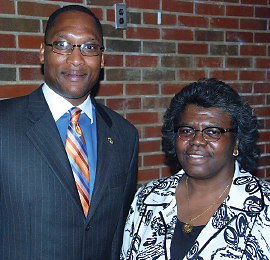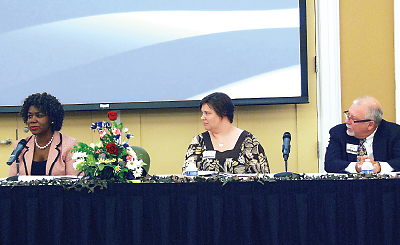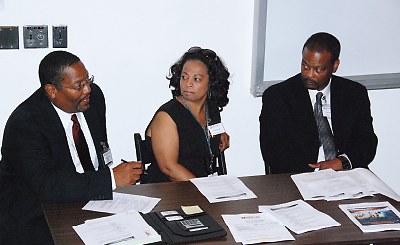Knowledge of Military Life Facilitates Vets' MH Care
Abstract
Clinicians are urged to recognize that military personnel live in a special culture and that understanding it can improve treatment outcomes.

Health care professionals should take the lead in meeting the needs of returning veterans, according to the Steptoe Group’s Ronald Steptoe and Evelyn Lewis, M.D.
A returning tide of military veterans seeking help readjusting to life back in the United States will need receptive mental health professionals with an understanding of military culture. Military service members and veterans believe strongly that “you have to know me to help me,” said Ronald Steptoe, chair of the Steptoe Group, a training and consulting company in Ellicott City, Md.
Steptoe spoke at a conference in July in Nashville cosponsored by Meharry Medical College, the National Medical Association, and APA’s Office of Minority and National Affairs (OMNA).
There are some basic points clinicians must know when treating military members and veterans, said Steptoe, a 1987 West Point graduate. Knowledge of military roles, the politics surrounding a war, and the nature of the enemy and the fighting are essential to effectively addressing the mental health needs of this population.
There are also more complex and subtle points—like rank—about which clinicians must be aware, he said. “Junior enlisted personnel will look at a provider as an authority figure and not disclose,” Steptoe cautioned. “Conversely, an officer may not trust the clinician for fear of harming career prospects.”
About 45 percent of the U.S. troops who served in Iraq and Afghanistan were in the National Guard or Reserve, people who had to leave civilian lives, families, and jobs to go to war. When they returned, they came back not to a military base like regular troops, surrounded by those with whom they served and where they had easy access to military health services, but to cities and small towns that may lack those services. They may have to rely on civilian providers rather than military or VA health systems.
Understanding these factors is a form of cultural competence and is as significant as any demographic characteristic, Steptoe emphasized. “Veterans are an emerging disparity group, and providers must build cultural communication strategies into their clinical practice,” he said.
“There is no more disparate health care delivery situation than that of the veteran seeking care and being unable to access it because of financial, geographic, or cultural barriers,” commented William Richie, M.D., an assistant professor of psychiatry and behavioral sciences and residency training director at Meharry Medical College, in an interview with Psychiatric News.

APA offers treatment guidelines for mental health professionals and educational material for the public, says Annelle Primm, M.D., M.P.H., director of APA’s Office of Minority and National Affairs. She spoke at a symposium on mental health care for returning troops along with Jennifer Abernathy, executive director of the Tennessee Respite Coalition, and Larry Malone, a former Navy pilot in Vietnam.
Posttraumatic stress disorder (PTSD), depression, and anxiety engendered by exposure to war are real illnesses that exact a heavy toll, said Annelle Primm, M.D., M.P.H., OMNA director and deputy APA medical director. “However, they can be treated effectively by looking at the whole person—family, socioeconomic situation, work, community, gender, and subculture.”
Women veterans face additional obstacles, said Mary Ross, of Nashville, national commander of the National Women Veterans of America. “The Department of Veterans Affairs was not adequately prepared for women,” said Ross. “They took a system that was designed for men and chipped away around the edges to make it fit for women.”
It’s important that veterans tell their stories as a step toward helping them heal, said Ross. “But at the same time, we have to be careful that we don’t give someone a disability,” she said. “Just because they have a diagnosis of PTSD, that does not mean they are disabled and do not have a purpose in life. We all need a purpose in life.”
Richie was disturbed by a trend toward what he called “the balkanization of care,” in which patients with particular gender, ethnic, or other cultural characteristics (veterans, for example) accept treatment only from clinicians who share that characteristic.

“We at Meharry are sensitive to our responsibility toward individuals who have given so much to us,” says William Richie, M.D. (left), an assistant professor of psychiatry. He spoke on a panel with Army veterans Jessica Lyons, manager of women’s treatment, and Samuel Scales, L.P.C., clinical director of Meharry’s Elam Mental Health Center.
“Mental health care givers are responsible for bridging that gap and reducing that balkanization,” said Richie, a former Air Force psychiatrist. “Fortunately, our partners at the VA are diligent in their orientation of our residents to the VA system.”
He acknowledged that working with veterans could be an up and down process.
“We have to accept that the first try may not hook the person into treatment,” he said. “Unfortunately, those attempts at therapy are interspersed with conflicts with family or conflicts with the law. And when that happens, you don’t want to sit back and say ‘I told you so.’ You want to sit back and say to the veteran ‘This is where you can come; we can talk about this; the door is still open.’ There’s still a window of opportunity.”
Opportunities exist not only for patients but for providers and others who recognize how great the need is for care for military veterans, Steptoe concluded. Medical organizations with the entrepreneurial spirit to create military-centric practices will succeed in that effort, he said. ■



